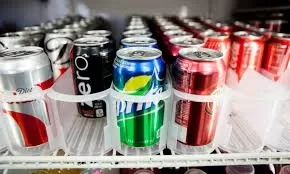Sugary Drinks and Their Bitter Impact on Global Health: A Wake-Up Call
Sugary drinks have long been a staple in diets around the world, but a new study reveals the harsh reality of their widespread consumption. In 2020 alone, sugary beverages caused a staggering 2.2 million new cases of type 2 diabetes globally.

Despite this alarming statistic, the consumption of these drinks continues to rise, especially in developing countries, where soft drink companies are targeting new customers in response to declining sales in North America and Europe. With diabetes and heart disease on the rise, the question remains: why is the sugary drinks market still growing, and what can be done to reverse this trend?
The Global Scale of the Problem
The study paints a grim picture of the health impact sugary drinks are having around the world. In addition to the 2.2 million cases of diabetes caused by sugary drinks in 2020, these beverages are also responsible for around 340,000 deaths from diabetes and approximately 1 million cases of cardiovascular disease annually. Despite decades of research highlighting the risks associated with sugary drinks—ranging from obesity and liver damage to hypertension and premature death—the global consumption of these drinks is still on the rise.
The effects are not evenly distributed, however. While North America and Europe have seen a decline in sugary drink consumption due to policy regulations, regions such as Sub-Saharan Africa and Latin America have experienced a sharp increase in consumption. In fact, three-quarters of deaths from cardiovascular disease now occur in low and middle-income countries, which are bearing the brunt of this rising epidemic.
Why Are Sugary Drinks So Harmful?
It is no secret that sugary drinks are bad for our health. These beverages flood the body with empty calories, offering little to no nutritional value while contributing significantly to weight gain. The consequences of regular sugary drink consumption are well documented, including:
- Obesity: The high sugar content in these drinks contributes to excess calorie intake, leading to weight gain and obesity.
- Liver damage: Excess sugar can strain the liver and contribute to fatty liver disease.
- Hypertension: High sugar intake can increase blood pressure, leading to greater cardiovascular risks.
- Heart disease: Sugary drinks increase the risk of developing heart disease due to their impact on blood sugar, cholesterol, and blood pressure levels.
- Type 2 diabetes: Consuming sugary drinks regularly can lead to insulin resistance, a key factor in the development of type 2 diabetes.
- Other complications: Long-term sugary drink consumption is associated with conditions like blindness, amputations, and premature death.
Despite this overwhelming evidence, the global consumption of sugary drinks continues to grow. In 2023, the sugary drinks market was valued at $216 billion, and by 2029, it is expected to reach $327 billion, an increase of more than $100 billion. This stark increase points to the growing influence of the beverage industry and the widespread availability and affordability of sugary drinks.
The Response: Education vs. Policy Change
Many countries have attempted to tackle the rising consumption of sugary drinks through education and awareness campaigns. However, decades of research show that education alone is not enough to curb consumption. While educating consumers about the health risks is important, it has not proven sufficient to change behaviors at a large scale.
A more robust approach is needed, one that includes policy control and measures that directly target the sugary drink industry. Several countries have begun to implement these policies with varying degrees of success. For example:
- Increased taxes: Many countries have introduced sugar taxes to make sugary drinks less affordable and discourage consumption.
- Bold warnings on packaging: Some countries have implemented graphic warning labels on sugary drink packaging, similar to those seen on tobacco products, to highlight the health risks associated with these beverages.
These policies are essential to curbing the consumption of sugary drinks, as they directly influence purchasing decisions and raise public awareness about the dangers of excessive sugar intake.
The Role of Governments and the Beverage Industry
The sugary drinks industry wields significant power, and its marketing strategies continue to drive consumption, particularly in developing countries where regulatory frameworks are weaker. For the sugary drinks market to shrink, governments must take decisive action to regulate the industry more effectively. This includes:
- Stronger regulations: Governments should enforce stricter labeling laws, ban advertising targeted at children, and limit the availability of sugary drinks in schools and public spaces.
- Subsidizing healthier alternatives: Providing incentives for the production and availability of healthier beverages, such as water, unsweetened teas, and natural fruit juices, can encourage people to make healthier choices.
- Collaborating with international organizations: Countries should work together to implement global standards and regulations aimed at reducing sugary drink consumption and improving public health.
The Road Ahead: A Collective Effort
There is no "magic bullet" solution to the global epidemic of sugary drink consumption, but a multifaceted approach involving education, policy changes, and industry regulations can make a significant difference. The sugary drinks market, which is expected to continue growing, is contributing to a rise in diabetes, heart disease, and other health problems that are costing lives and straining healthcare systems worldwide.
To tackle this crisis effectively, governments, public health organizations, and consumers must work together to create a healthier future. Stronger policies, such as taxes, warning labels, and public education, must be implemented alongside efforts to reduce the availability of sugary drinks in everyday life.
In the end, the battle against sugary drinks is not just about making the right choices as individuals but also about holding the beverage industry accountable and pushing for stronger policies that protect public health. The rise in sugary drink consumption, if left unchecked, will only lead to more cases of preventable diseases and death. It is time for governments around the world to take stronger, more decisive action.
Conclusion: A Wake-Up Call for Global Health
The global health community must take note of the alarming rise in sugary drink consumption and its dire health consequences. With 2.2 million new cases of type 2 diabetes and millions more affected by heart disease annually, the time for action is now. While individual choices play a role, systemic changes—such as taxes, better labeling, and greater regulation—are necessary to shift global habits and protect public health. The sugary drinks industry is set to grow even larger in the coming years, but it is up to policymakers and global citizens to decide whether that growth will come at the cost of our health or whether we can turn the tide toward a healthier future.
What's Your Reaction?

















